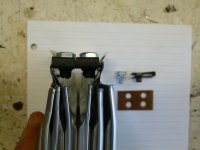oatnet
1 MW
dnmun said:it was my fault for mentioning the idea of a brass split pin, cotter key. i was thinking of the difficulty soldering to the steel, and was thinking brass would make it easier. i had totally missed how ebv rolled this and clamped it in the vise and put the washer on it when i first saw the pictures. now i like JD's idea about using a spot welder first and rolling it up after. just am thinking of the sense wire all the time.
I was able to roll the balance wire into the crimp, although it was a challenge, and thicker strands worked better than fine strands. Since the balance wire only sees a handful of amps instead of 100's, it needs very little contact area, and the risk from doing it badly is having resistance cause an inefficient balance charge (not regular bulk charges) for that cell, very little wasted current.
-JD










